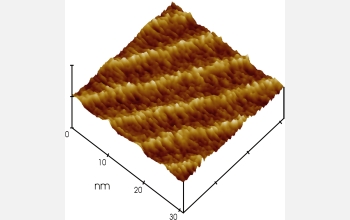Multimedia Gallery
Biosurfactant -Cu2+ organized assemblies on graphite
Atomic force microscopy image of biosurfactant -Cu2+ organized assemblies spontaneously absorbed on graphite surfaces intended to model soil organic matter.
Surfactants--or surface-active agents--are substances that lower the surface tension, forming a membrane-like barrier between different liquid phases that affects the ability of molecules to move from one phase to another. In addition to synthetically produced surfactants, these substances are also produced by a wide diversity of microorganisms. Some types of biosurfactants can bind tightly to toxic metals, such as lead and cadmium, while others can adhere strongly to surfaces, sometimes completely changing the properties of the surface.
Researchers want to know how biosurfactant production in soil systems influences the behavior of toxic metal contaminants. To answer this question, a microbiologist, a surface chemist and an expert in NMR spectroscopy are working together to discover (1) how much of the class of biosurfactants known as rhamnolipids are produced in soil; (2) how these rhamnolipids complex toxic metals such as lead and cadmium; and (3) how these biosurfactants interact with soil surfaces in the presence and absence of metals. This information is a critical piece of the puzzle required for understanding how metals are mobilized and immobilized under both natural and engineered conditions.
This research is supported by a grant from the National Science Foundation (CHE 01-33237), awarded to Raina M. Maier and Jeanne E. Pemberton at the University of Arizona, and Cynthia K. Larive at the University of Kansas. (Year of image: 2003) [Image 2 of 2 related images. See Image 1.]
Credit: Raina M. Maier and Jeanne E. Pemberton, University of Arizona
Images and other media in the National Science Foundation Multimedia Gallery are available for use in print and electronic material by NSF employees, members of the media, university staff, teachers and the general public. All media in the gallery are intended for personal, educational and nonprofit/non-commercial use only.
Images credited to the National Science Foundation, a federal agency, are in the public domain. The images were created by employees of the United States Government as part of their official duties or prepared by contractors as "works for hire" for NSF. You may freely use NSF-credited images and, at your discretion, credit NSF with a "Courtesy: National Science Foundation" notation.
Additional information about general usage can be found in Conditions.
Also Available:
Download the high-resolution TIFF version of the image. (23.5 MB)
Use your mouse to right-click (Mac users may need to Ctrl-click) the link above and choose the option that will save the file or target to your computer.

